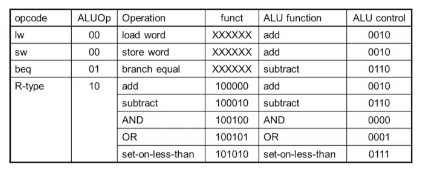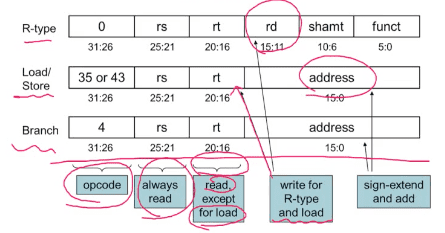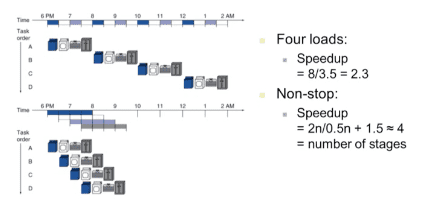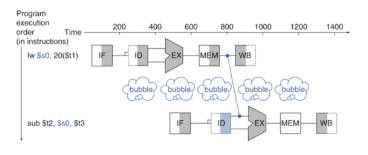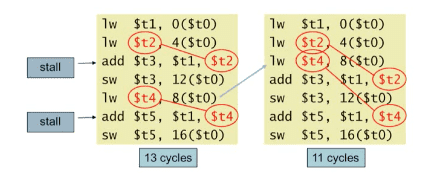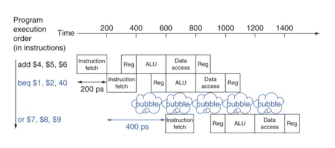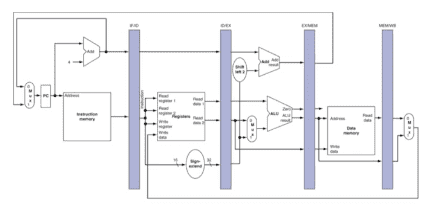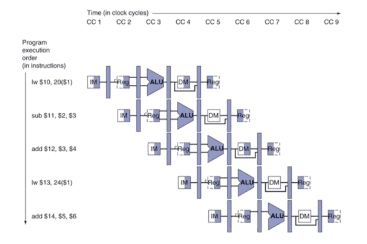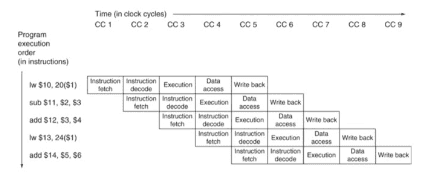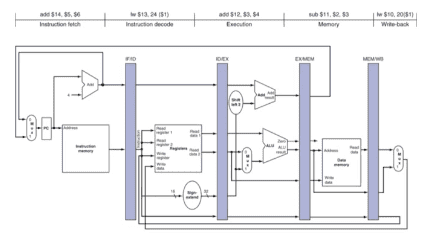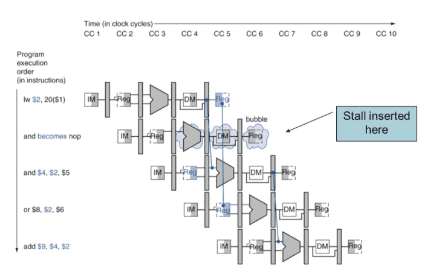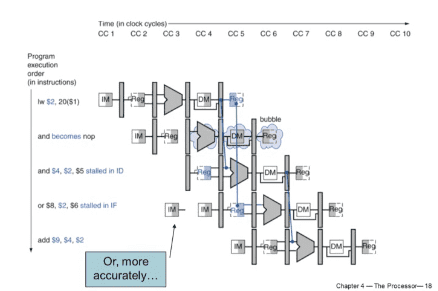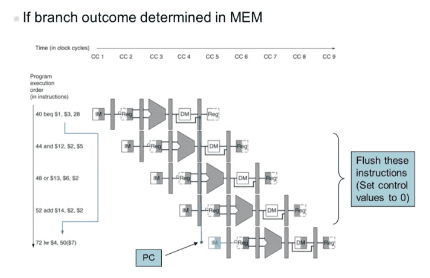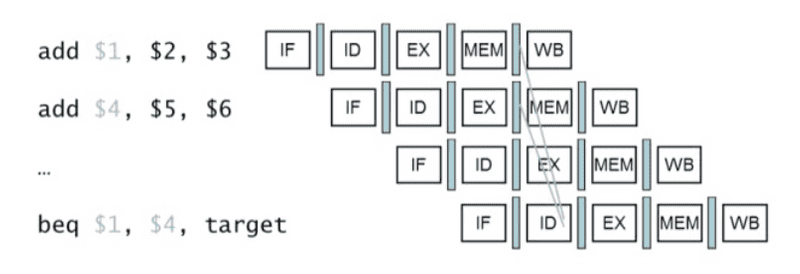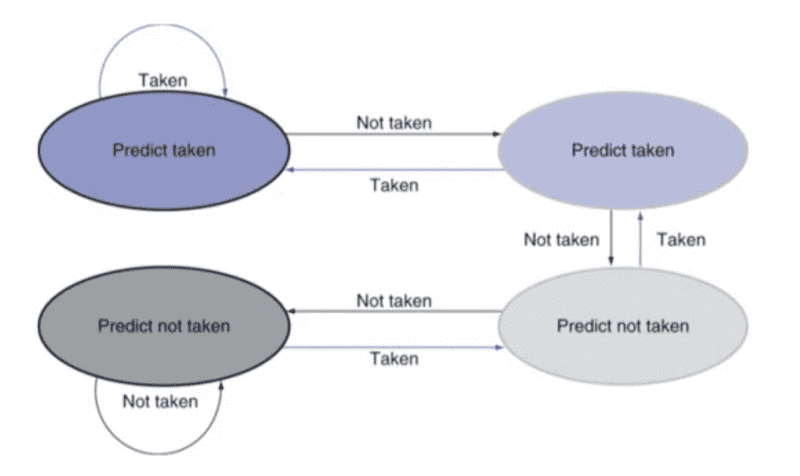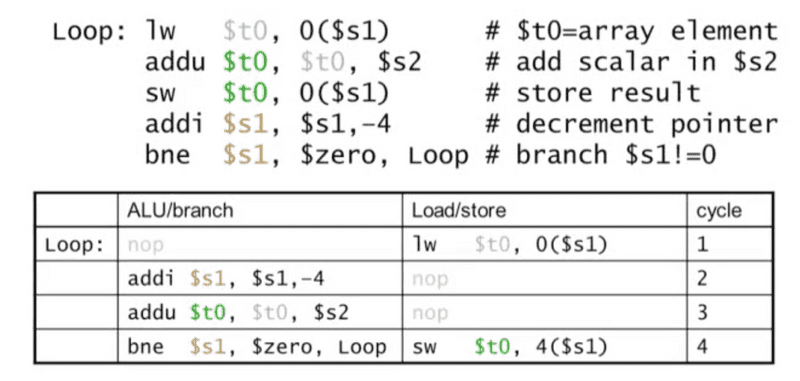[컴퓨터구조론] 4. The Processor
2020-09-16
본 글은 영남대학교 최규상 교수님의 컴퓨터 구조 강의를 듣고 작성된 글입니다.
4.1 Introduction
-
CPU performance factors
-
Instruction count
- Determined by ISA and compiler
-
CPI and Cycle time
- Determined by CPU hardware
-
-
We will examine two MIPS implementations
- A simplified version
- A more realistic pipelined version
-
Instruction Execution
- PC (program counter) -> instruction memory, fetch instruction
- Register numbers -> register file, read registers
-
Depending on instruction class
-
Use ALU to calculate
- Arithmetic result
- Memory address for load/store
- Branch target address
- Access data memory for load/sotre
- PC <- target address or PC + 4
-
- CPU Overview
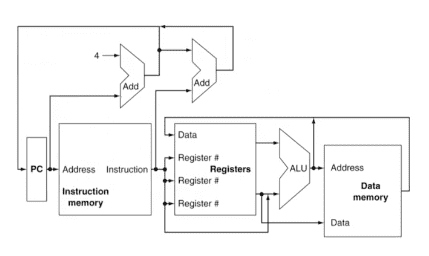
4.2 Logic Design Conventions
-
Loginc Design Basics
-
Information encoded in binary
- Low voltage = 0, High voltage = 1
- One wire per bit
- Multi-bit data encoded on multi-wire buses
-
Combinational element
- Operate on data
- Output is a function of input
-
State (sequential) elements
- Store information
-
-
Clocking Methodology
-
Combinational logic transforms data during clcock cycles
- Between clock edges
- Input from state elements, output to state element
- Longest delay determines clock period
-
4.3 Building a Datapath
-
Building a Datapath
-
Datapath
-
Elements that process data and addresses in the CPU
- Registers, ALUs, mux's, memories, ...
-
-
We will build a MIPS datapath incrementally
- Refining the overview design
-
-
R-Format Instructions
- Read two register operands
- Perform arithmetic/logical operation
- Write register result
-
Load/Store Instructions
- Read register operands
-
Calculate address using 16-bit offset
- Use ALU, but sign-extend offset
- Load: Read memory and update register
- Store: Write register value to memory
-
Branch Instructions
- Read register operands
-
Compare operands
- Use ALU, subtract and check Zero output
-
Calculate target address
- Sign-extend displacement
- Shift left 2 places (word displacement)
- Add to PC + 4 Already calculated by instruction fetch
- Full Datapath
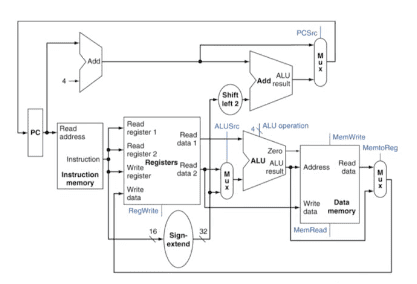
4.4 A Simple Implement Scheme
-
ALU Control
-
The Main Control Unit
- Datapath With Control
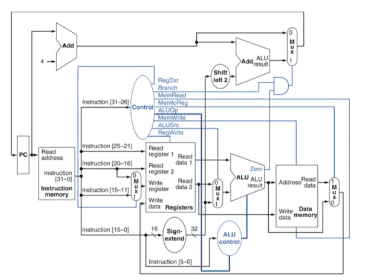
-
Performance Issues
-
Longest delay determines clock period
- Critical path: load instruction
- Instruction memory -> register file -> ALU -> data memory -> register file
- Not feasible to vary period for different instructions
-
Violates design principle
- Making the common case fast
- We will improve performance by pipelining
-
4.5 An Overview of Pipelining
-
Pipelined laundry: overlapping execution
- Parallelism improves performance
-
MIPS Pipeline
-
Five stages, one step per stage
- IF: Instruction fetch from memory
- ID: Instruction decode & register read
- EX: Execute operation or calculate address
- MEM: Access memory operand
- WB: Write result back to register
-
-
Pipeline Performance
-
Assume time for stages is
- 100ps for register read or write
- 200ps for other stages
- Compare pipelined datapath with single-cycle datapath
-
- Pipeline Performance
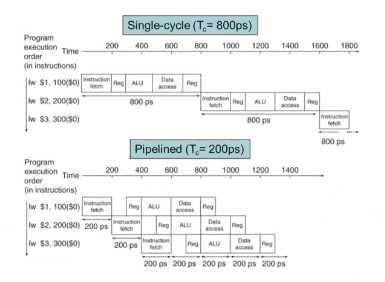
-
Pipeline Speedup
-
If all stages are balanced
- i.e., all take the same time
Time between instructions(pipelined) = Time between instructions(nonpipelined) / Number of stages- If not balanced, speedup is less
-
Speedup due to increased throughput
- Latency (time for each instruction) does not decrease
-
-
Pipelining and ISA Design
-
MIPS ISA designed for pipelining
-
All instructions are 32-bits
- Easier to fetch and decode in one cycle
- c.f. x86: 1 - to 17 byte instructions
-
Few and regular instruction formats
- Can decode and read registers in one step
-
Load/store addressing
- Can calculate address in 3nd stage, access memory in 4th stage
-
Alignment of memory operands
- Memory access takes only one cycle
-
-
4.5 An Overview of Pipelining
-
Hazards
- Situations that prevent starting the next instruction in the next cycle
-
Structure hazards
- A required resource is busy
-
Data hazard
- Need to wait for previous instruction to complete its data read/write
-
Control hazard
- Deciding on control action depends on previous instruction
-
Structure Hazards
- Conflict for use of a resource
-
In MIPS pipeline with a signle memory
- Load/Store requires data access
-
Insturction fetch would have to stall for that cycle
- Would cause a pipeline "bubble"
-
Hence, pipelined datapaths require separate instruction/data memories
- Or seperate instruction/data caches
-
Data Hazards
-
Fowarding
-
Use result when it is computed
- Don't wait for it to be stored in a register
- Requires extra connections in the datapath

-
-
Load-Use Data Hazard
-
Code Scheduling to Avoid Stalls
-
Control Hazards
-
Branch determines flow of control
- Fetching next instruction depends on branch outcome
-
Pipeline can't always fetch correct instruction
- Still working on ID stage of branch
-
In MIPS pipeline
- Need to compare registers and compute target early in the pipeline
- Add hardware to do it in ID stage
-
-
Stall on Branch
-
Branch Prediction
-
Longer pipelines can't readily determine branch outcome early
- Stall penalty becomes unacceptable
-
Predict outcome of branch
- Only stall if prediction is wrong
-
In MIPS pipeline
- Can predict branches not taken
- Fetch instruction after branch, with no delay
-
- MIPS with Predict Not Taken
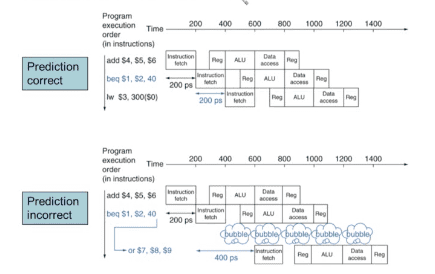
-
More-Realistic Branch Prediction
-
Static branch prediction
- Based on typical branch behavior
-
Example: loop and if-statement branches
- Predict backward branches taken
- Predict forward branches not taken
-
Dynamic branch prediction
-
Hardware measures actual branch behavior
- e.g., record recent history of each branch
-
Assume future behavior will continue the tred
- When wrong, stall while re-fetching, and update history
-
-
-
Pipeline Summary
-
Pipelining improves performance by increasing instruction throughput
- Executes multiple instructions in parallel
- Each instruction has the same latency
-
Subject to hazards
- Structure, data, control
- Instruction set design affects complexity of pipeline implementation
-
4.6 Pipelined Datapath and Control
- MIPS Pipelined Datapath
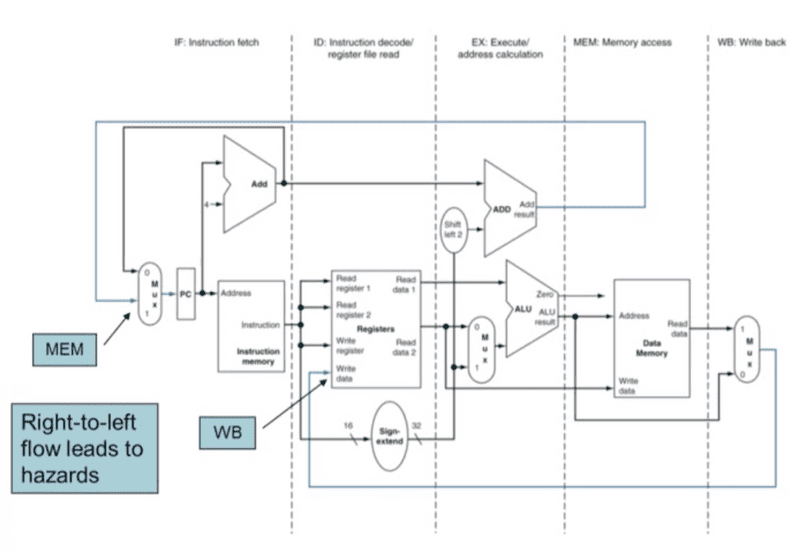
-
Pipeline registers
-
Pipeline Operation
-
Cycle-by-cycle flow of instructions through the pipelined datapath
-
"Single-clock-cycle" pipeline diagram
- Shows pipeline usage in a signle cycle
- Highlight resources used
-
c.f. "multi-clock-cycle" diagram
- Graph of operation over time
-
-
-
Multi-Cycle Pipeline Diagram
-
Single-Cycle Pipeline Diagram
- Pipelined Control (Simplified)

-
Pipelined Control
4.7 Data Hazards: Forwarding vs Stalling
-
Data Hazards in ALU Instructions
-
Consider this sequence:
sub $2, $1, $3 and $12, $2, $5 or $13, $6, $2 add $14, $2, $2 sw $15, 100($2) -
We can resolve hazards with forwarding
- How do we detect when to forward?
-
- Dependencies & Forwarding
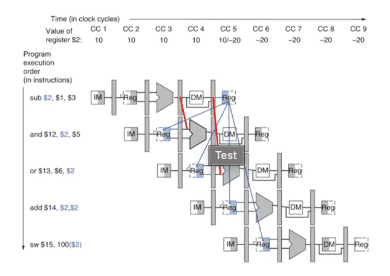
-
Detecting the Need to Forward
-
Pass register numbers along pipeline
- e.g., ID/EX.RegisterRs = register number for Rs sitting in ID/EX pipeline register
-
ALU operand register numbers in EX stage are given by
- ID/EX.RegisterRs, ID/EX.RegisterRt
-
Data hazards when
- EX/MEM.RegisterRd = ID/EX.RegisterRs
- EX/MEM.RegisterRd = ID/EX.RegisterRt
- MEM/WB.RegisterRd = ID/EX.RegisterRs
- MEM/WB.RegisterRd = ID/EX.RegisterRt
-
-
Detecting the Need to Foward
-
But only if forwarding instruction will write to a register!
- EX/MEM.RegWrite, MEM/WB.RegWrite
-
And only if Rd for that instruction is not $zero
- EX/MEM.RegisterRd != 0
- MEM/WB.RegisterRd != 0
-
- Forwarding Paths
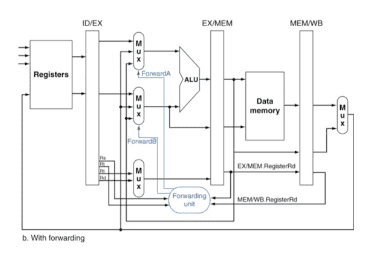
- Forwarding Conditions

-
Double Data Hazard
-
Consider the sequence
add $1, $1, $2 add $1, $1, $3 add $1, $1, $4 -
Both hazards occur
- Want to use the most recent
-
Revise MEM hazard condition
- Only fwd if EX hazard condition isn't true
-
- Revised Forwarding Condition
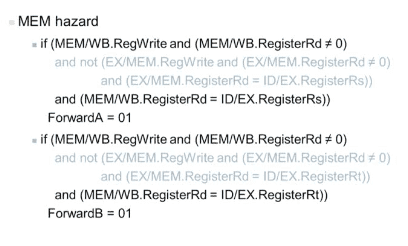
- Datapath with Forwarding
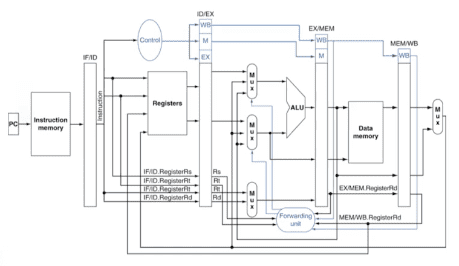
- Load-Use Data Hazard

-
Load-Use Hazard Detection
- Check when using instruction is decoded in ID stage
-
ALU operand register numbers in ID stage are given by
- IF/ID.RegisterRs, IF/ID.RegisterRt
-
Load-use hazard when
- ID/EX.MemRead and ((ID/EX.RegisterRt = IF/ID.RegisterRs) or (ID/EX.RegisterRt = IF/ID.RegisterRt))
- If detected, stall and insert bubble
-
How to Stall the Pipeline
-
Force control values in ID/EX register to 0
- EX, MEM, and WB do nop (no-operation)
-
Prevent update of PC and IF/ID register
- Using instruction is decoded again
- Following instruction is fetched again
-
1-cycle stall allows MEM to read data for lw
- Can subsequently forward to EX stage
-
-
Stall/Bubble in the Pipeline
- Datapath with Hazard Detection
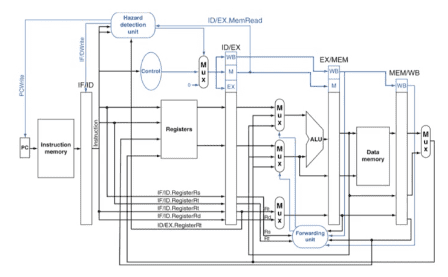
-
Stalls and Performance
-
Stalls reduce performance
- But are required to get correct results
-
Compiler can arrange code to avoid hazards and stalls
- Requires knowledge of the pipeline structure
-
-
Branch Hazards
-
Reducing Branch Delay
-
Move hardware to determine outcome to ID stage
- Target address adder
- Register address adder
-
- Example: Branch Taken
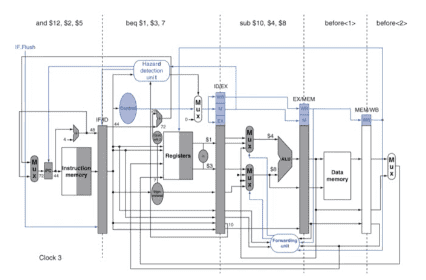
4.8 Control Hazards
-
Data Hazards for Branches
-
Dynamic Branch Prediction
- In deeper and superscalar pipelines, branch penalty is more significant
-
Use dynamic prediction
- Branch prediction buffer (aka branch history table)
- Indexed by recent branch instruction addresses
- Stores outcome (taken/not taken)
-
To execute a branch
- Check table, expect the same outcome
- Start fetching from fall-through or target
- If wrong, flush pipeline and flip prediction
-
1-Bit Predictor: Shortcoming
-
Inner loop branches mispredicted twice
- Mispredict as taken on last iteration of inner loop
- Then mispredict as not taken on first iteration of inner loop next time around
-
-
2-Bit predictor
-
Calculating the Branch Target
-
Even with predictor, still need to calculate the target address
- 1-cycle penalty for a taken branch
-
Branch target buffer
- Cache of target addresses
-
Indexed by PC when instruction fetched
- If hit and instruction is branch predicted taken, can fetch target immediately
-
4.9 Exceptions
-
Exceptions and Interrupts
-
"Unexpected" events requiring change in flow of control
- Different ISAs use the terms differently
-
Exception
-
Arises within the CPU
- e.g., undefined opcode, overflow, syscall, ...
-
-
Interrupt
- From an external I/O controller
-
Trap (Software Interrupt)
- System call을 사용할 때 발생, 소프트웨어가 명령어를 수행할 때 interrupt가 발생하는 것
- Dealing with them without sacrificing performance is hard
-
-
Handling Exceptions
- In MIPS exceptions managed by a System Control Coprocessor (CP0)
-
Save PC of offending (or interrupted) instruction
- In MIPS: Exception Program Counter (EPC)
-
Save indication of the problem
- In MIPS: Cause register
-
We'll assume 1-bit
- 0 for undefined opcode,1 for overflow
- Jump to handler at 8000 00180
-
An Alternate Mechanism
-
Vectored Interrupts
- Handler address determined by the cause
-
Example:
- Undefined opcode: C000 0000
- Overflow: C000 0020
- ...: C000 0040
-
Instructions either
- Deal with the interrupt, or
- Jump to real handler
-
-
Handler Actions
- Read cause, and transfer to relevant handler
- Determine action required
-
If restartable
- Take corrective action
- use EPC to return to program
-
Otherwise
- Terminate program
- Report error using EPC, cause, ...
-
Exceptions in a Pipeline
- Another form of control hazard
-
Consider overflow on add in EX stage
- add $1, $2, $1
- Prevent $1 from being clobbered
- Complete previous instructions
- Flush add and subsequent instructions
- Set Cause and EPC register values
- Transfer control to handler
-
Similar to mispredicted branch
- Use much of the same hardware
- Pipeline with Exceptions

-
Exception Properties
-
Restartable exceptions
- Pipeline can flush the instruction
-
Handler executes, then returns to the instruction
- Refetched and executed from scratch
-
PC saved in EPC register
- Identifies causing instruction
-
Actually PC + 4 is saved
- Handler must adjust
-
- Exception Example
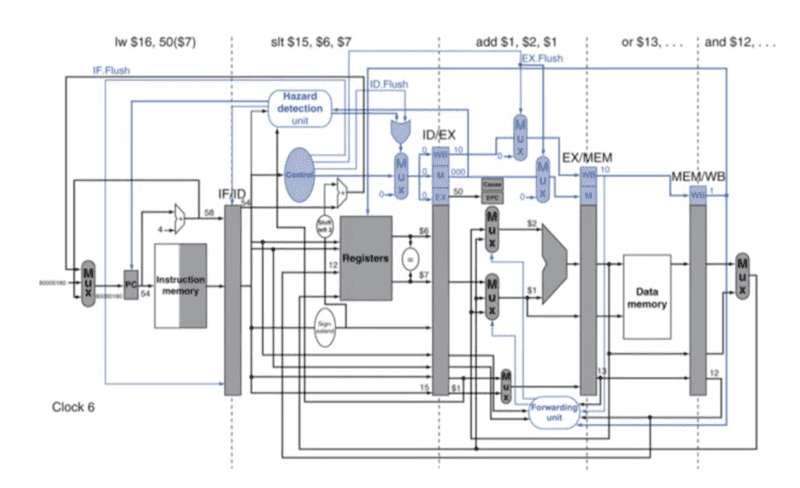
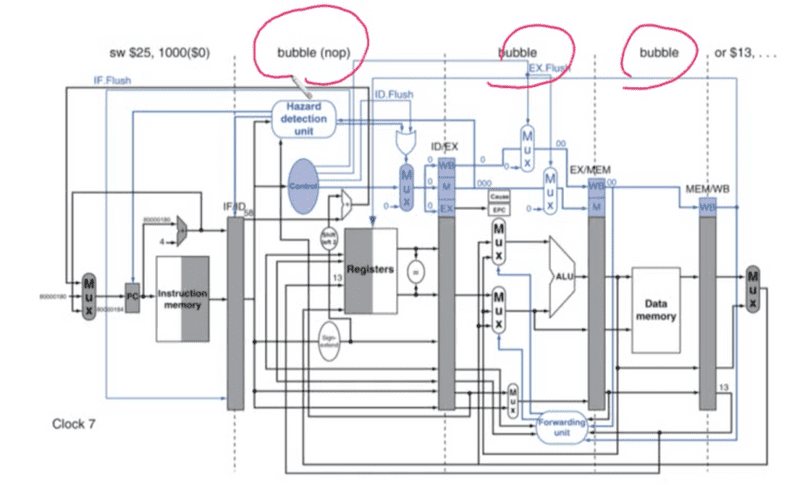
-
Multiple Exceptions
-
Pipelining overlaps multiple instructions
- Could have multiple exceptions at once
-
Simpe approach: deal with exception from earliest instruction
- Flush subsequent instructions
- "Precise" exceptions
-
In complex pipelines
- Multiple instructions issued per cycle
- Out-of-order completion
- Maintaining precise exceptions is difficult
-
-
Imprecise Exceptions
-
Just stop pipeline and save state
- Including exception cause(s)
-
Let the handler work out
- Which instruction(s) had exceptions
-
Which to complete or flush
- May require "manual" completion
- Simplifies hardware, but more complex handler software
- Not feasible for complex multiple-issue out-of-order pipelines
-
4.10 Parallelism via Instructions
-
Instruction-Level Parallelism (ILP)
- Pipelining: executing multiple instructions in parallel
-
To increase ILP
-
Deeper pipeline
- Less work per stage -> shorter clock cycle
-
Multiple issue
- Replicate pipeline stages -> multiple pipelines
- Start multiple instructions per clock cycle
- CPI < 1, so use Instructions Per Cycle (IPC)
-
E.g., 4GHz 4-way multiple-issue
- 16 BIPS, peak CPI = 0.25, peak IPC = 4
- But dependencies reduce this in practice
-
-
Multiple Issue
-
Static multiple issue
- Compiler groups instructions to be issued together
- Packages them into "issue slots"
- Compiler detects and avoids hazards
-
Dynamic multiple issue
- CPU examines instruction stream and cooses instructinos to issue each cycle
- Compiler can help by reordering instructions
- CPU resolves hazards using advanced techniques at runtime
-
-
Speculation
-
"Guess" what to do with an instruction
- Start operation as soon as possible
-
Check whether guess was right
- If so, complete the operation
- If not, roll-back and do the right thing
- Common to static and dynamic multiple issue
-
Examples
-
Speculate on branch outcome
- Roll back if path taken is different
-
Speculate on load
- Roll back if location is updated
-
-
-
Compiler/Hardware Speculation
-
Compiler can reorder instructions
- e.g., move load before branch
- Can include "fix-up" instructions to recover from incorrect guess
-
Hardware can loock ahead for instructions to execute
- Buffer results until it determines they are actually needed
- Flush buffers on incorrect speculation
-
-
Speculation and Exceptions
-
What if exception occurs on a speculatively executed instruction?
- e.g., speculative load before null-pointer check
-
Static speculation
- Can add ISA support for deferring exceptions
-
Dynamic speculation
- Can buffer exceptions untill instruction completion (which may not occur)
-
-
Static Multiple Issue
-
Compiler groups instructions into "issue packets"
- Group of instructions that can be issued on a signle cycle
- Determined by pipeline resources required
-
Think of an issue packet as a very long instruction
-
Specifies multiple concurrent operations
- Very Long Instruction Word (VLIW)
-
-
-
Scheduling Static Multiple Issue
-
Compiler must remove some/all hazards
- Reorder instructions into issue packets
- No dependencies with a packet
-
Possibly some dependencies between packets
- Varies between ISAs; compiler must know!
- Pad with nop if necessary
-
-
MIPS with Static Dual Issue
- MIPS with Static Dual Issue (Datapath)
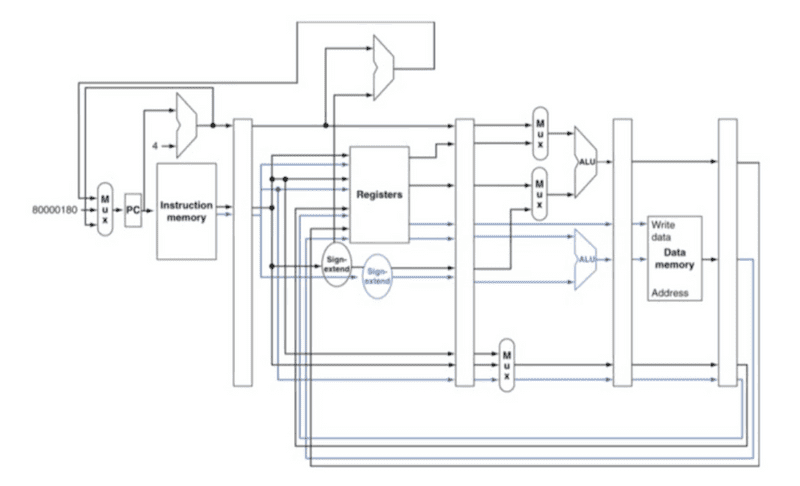
-
Hazards in the Dual-Issue MIPS
- More instructions executing in parallel
-
EX data hazard
- Forwarding avoided stalls with single-issue
-
Now can't use ALU result in load/store in same packet
add $t0, $s0, $s1 load $s2, 0($t0)- split into two packets, effectively a stall
-
Load-use hazard
- Still one cycle use latency, but now two instructions
- More aggressive scheduling required
-
Scheduling Example
-
Loop Unrolloing
- pass
-
Dynamic Multiple Issue
- "Superscalar" processors
-
CPU decides whether to issue 0, 1, 2, ... each cycle
- Avoiding structural and data hazards
-
Avoids the need for compiler scheduling
- Though it may still help
- Code semantics ensured by the CPU
-
Dynamic Pipeline Scheduling
-
Allow the CPU to execute instructions out of order to avoid stalls
- But commit result to registers in order
-
Example
lw $t0, 20($s2) addu $t1, $t0, $t2 sub $s4, $s4, $t3 slti $t5, $s4, 20- Can start sub while addu is waiting for lw
-
- Dynamically Scheduled CPU
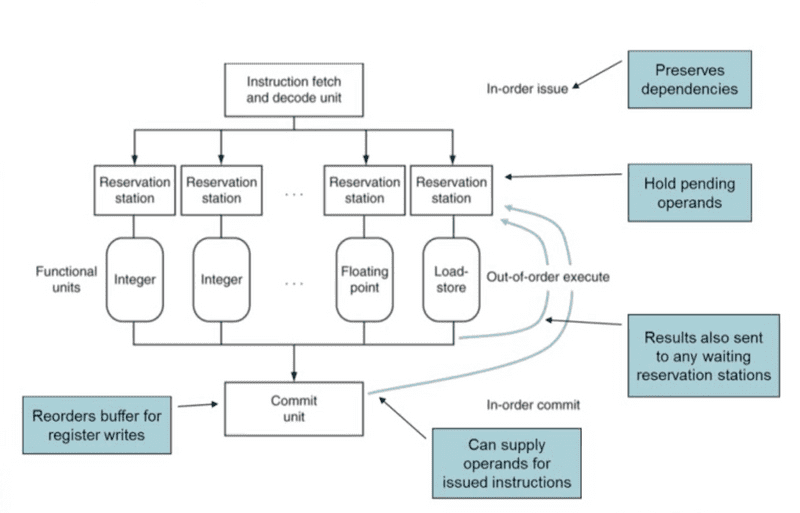
-
Register Renaming
- Reservation stations and reorder buffer effectively provide register renaming
-
On instruction issue to reservation station
-
If operand is available in register file or reorder buffer
- Copied to reservation station
- No longer required in the register; can be overwritten
-
If operand is not yet available
- It will be provided to the reservation station by a function unit
- Register update may not be required
-
-
Speculation
-
Predict branch and continue issuing
- Don't commit until branch outcome determined
-
Load speculation
-
Avoid load and cache miss delay
- predict the effective address
- predict loaded value
- Load before completing outstanding stores
- Bypass stored values to load unit
- Don't commit load until speculation cleared
-
-
-
Why Do Dynamic Scheduling?
-
Why not just let the compiler schedule code?
-
Not all stalls are predicable
- e.g., cache misses
-
Can't always schedule around branches
- Branch outcome is dynamically determined
- Different implementations of an ISA have different latencies and hazards
-
-
-
Does Multiple Issue Work?
- Yes, but not as much as we'd like
- Programs have real dependencies that limit ILP
-
Some depnedencies are hard to eliminate
- e.g., pointer aliasing
-
Some parallelism is hard to expose
- Limited window size during instruction issue
-
Memory delays and limited bandwith
- Hard to keep pipelines full
- Speculation can help if done well
-
Power Efficiency
- Complexity of dynamic scheduling and speculations requires powew
- Multiple simpler cores may be better
4.11 Real Stuff: The ARM Cortex-A8 and Intel COre i7 Pipelines
- pass
4.12 Instruction-Level Parallelism and Matrix Multiply
- pass
4.14 Fallacies and Pitfalls
-
Fallacies
-
Pipelining is easy (!)
- The basic idea is easy
-
The devil is in the details
- e.g., detecting data hazards
-
Pipelining is independent of technology
- So why haven't we always done pipelining?
- More transistors make more advanced techniques feasible
-
Pipeline-realted ISA design needs to take account of technology trends
- e.g., predicated instructions
-
-
Pitfalls
-
Poor ISA design can make pipelining harder
-
e.g., complex instruction sets (VAX, IA-32)
- Significant overhead to make pipelining work
- IA-32 micro-op approach
-
e.g., complex addressing modes
- Register update side effects, memory indirection
-
e.g., delayed branches
- Advanced pipelines have long delay slots
-
-
4.15 Concluding Remarks
-
Concluding Remarks
- ISA influences design of datapath and control
- Datapath and control influence design of ISA
-
Pipelining improves instructino throughput using parallelism
- More instructions completed per second
- Latency for each instruction not reduced
- Hazards: structural, data, control
-
Multiple issue and dynamic scheduling (ILP)
- Dependencies limit achievable parallelism
- Complexity leads to the power wall
